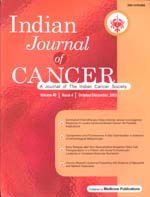
|
Indian Journal of Cancer
Medknow Publications on behalf of Indian Cancer Society
ISSN: 0019-509X
EISSN: 0019-509X
Vol. 42, No. 3, 2005, pp. 151-154
|
 Bioline Code: cn05026
Bioline Code: cn05026
Full paper language: English
Document type: Research Article
Document available free of charge
|
|
|
Indian Journal of Cancer, Vol. 42, No. 3, 2005, pp. 151-154
| en |
Transrectal ultrasound guided biopsy for detecting early prostate cancer: An Indian experience
Gupta NP, Ansari MS, Dass SC
Abstract
BACKGROUND: With the advent of prostate specific antigen the number of patients undergoing prostate biopsy has dramatically increased. The sextant biopsy technique has been conventionally used for the diagnosis of prostate cancer. Recently, concern has arisen that the original sextant method may not include an adequate sample of the prostate, hence it may result in high false negative rates. We conducted a prospective study to determine whether the 5-region prostate biopsy technique significantly increases the chance of prostate cancer detection as compared to the sextant biopsy technique.
AIMS: To evaluate the efficacy of TRUS guided sextant and 5-region biopsy techniques in detecting carcinoma prostate in patients with PSA between 4 and 10 ng/ml and normal digital rectal examination.
METHODS AND MATERIAL: Between December 2001 and August 2003 one forty-two men, aged 49-82 years, who presented with LUTS, normal digital rectal examination (DRE) and PSA between 4 and 10 ng/ml underwent TRUS guided sextant prostate biopsy. Serum PSA was reassessed after 3 months in patients whose biopsies were negative for cancer. If PSA was still raised, the patients underwent extensive 5-region biopsy.
RESULTS: Mean patient age was 64 years and median PSA was 6.9 ng/ml. TRUS guided sextant biopsy revealed adenocarcinoma prostate in 34 men (24%). Median Gleason score was 7. Seven men (4.9%) had cellular atypia and 3(2.1%) had prostatic intraepithelial neoplasia (high grade). On repeat PSA estimation after 3 months, 48 patients showed stagnant or rising trend for which they underwent TRUS guided 13-core biopsy. Five (10.4%) patients were detected to have adenocarcinoma on repeat biopsy. Biopsy negative patients are on regular follow up with yearly PSA estimation. Complications included transient mild haematuria in14 patients (9.82%) and haematospermia in 4 (2.8%). Urinary retention developed in one patient and required an indwelling catheter for 4 days.
CONCLUSION: Transrectal ultrasound guided sextant biopsy has shown a false negative rate of approximately 11%. A repeat 5- region (13-core) biopsy strategy can decrease the false negative rate of conventional sextant biopsy in patients with previously negative biopsies but persistently high PSA levels, high grade PIN or cellular atypia.
Keywords
Prostate specific antigen, Prostate cancer, Prostate biopsy, Transrectal ultrasonography, Sextant biopsy
|
| |
© Copyright 2005 Indian Journal of Cancer.
Alternative site location: http://www.indianjcancer.com/
|
|
